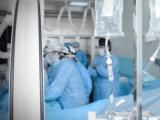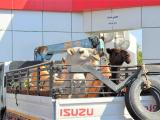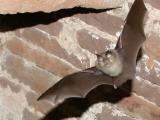May 22, 2013 (CIDRAP News) – Saudi Arabia reported today that a foreigner died yesterday of a MERS-CoV (Middle East respiratory syndrome coronavirus) infection, while health officials in Jordan offered new details—some of them puzzling—about a hospital cluster of cases that occurred there in April 2012.
In a brief statement, the Saudi Ministry of Health (MOH) announced "the demise of a non-Saudi case of novel Coronavirus in al-Qassim region," a province in the central part of the country. The person was hospitalized a few days ago with a severe respiratory illness and died yesterday, the statement said.
The MOH gave no information on the patient's age, gender, nationality, previous health status, occupation, residency status, or possible exposures to the virus. The statement noted that no new cases have emerged in the past 5 days in the Al-Ahsa region in Eastern province, site of a hospital-centered MERS-CoV outbreak involving 22 cases.
The announcement comes a day after a press report that a World Health Organization (WHO) expert, Anthony Mounts, MD, expressed concern that guest workers in the Middle East could spread the novel virus to their home countries, particularly India and the Philippines.
The WHO said today that the death toll in the Al-Ahsa outbreak has increased to 10 with the death of a patient whose case was announced earlier. The WHO gave no other information about the patient, and it wasn't immediately clear if the death is the same one that was noted by the Saudi MOH in a May 20 statement.
Today's WHO statement also offered some details on the two confirmed MERS-CoV cases and one probable case in a Tunisian family, which were first reported by the media 2 days ago. They were the first known cases in Tunisia.
The probable case was in a 66-year-old man who got sick 3 days after returning from a trip to Qatar and Saudi Arabia on May 3, the WHO said. After being hospitalized, he died on May 10. Initial lab tests for the virus were negative, the agency reported.
The two confirmed cases involved the man's 34-year-old son and 35-year-old daughter, who had mild respiratory illnesses and were not hospitalized, the WHO said. Officials are still investigating the outbreak and monitoring the patients' close contacts for signs of illness.
The WHO said the global count for MERS-CoV stood at 43 cases with 21 deaths, the same as cited by a WHO official via Twitter yesterday. As of this writing, the agency has not yet noted the fatal case announced by the Saudi health ministry today.
Jordanian cluster
Details on the Jordanian case cluster were provided yesterday in an online report from the Eastern Mediterranean Health Journal, published by the WHO's Regional Office for the Eastern Mediterranean.
The hospital cluster involved 2 confirmed and 11 probable cases in April 2012. They marked the emergence of MERS-CoV, but they were not identified as such until about 7 months later, after the discovery of the virus in a Saudi Arabian man and a Qatari in September.
After the virus was discovered, Jordanian officials sent stored samples from some of the patients to a US Navy laboratory in Cairo, and two of them tested positive in November. Both of the confirmed case-patients died, while all the probable cases survived.
Of the 13 confirmed and probable cases, 10 were in healthcare workers (HCWs) and 2 were in family contacts of patients, according to the report by Jordanian Ministry of Health officials. They occurred in the public hospital in Zarqa, Jordan's second-largest city.
Investigators found that the illnesses came in two waves or phases: four with onset between Mar 21 and Apr 2, and nine with onset between Apr 11 and 26. Only three patients were women, which is in line with the findings for MERS-CoV cases in general. But the median age was only 33, as compared with a median of 56 years for the recent Saudi case cluster.
The first (index) case in the cluster was in a 25-year-old university student who got sick on Mar 21 but was not hospitalized until Apr 4, according to the report. The second and third cases involved a 30-year-old male nurse who fell ill on Mar 30 and a 40-year-old female nurse who got sick on Apr 2. The 25-year-old and the 40-year-old were the patients who died and whose cases were later confirmed.
The index patient, who died on Apr 25, had no travel history and no reported contact with animals in the 10 days before his first symptoms. His contacts included the second and third case-patients, as well as his mother, who remained healthy.
Oddly, however, the second and third patients got sick before the first case-patient was hospitalized, leaving it unclear how the second patient became infected. Among other possibilities, the authors speculate that the two nurses might have been exposed to the index case in an outpatient clinic, before he was admitted to the hospital.
The nine patients in the second phase of the cluster all had probable cases, and all but one were likely to have had significant contact with at least one of the two confirmed case-patients, according to the report.
In other findings, the report says:
- To prevent "stigmatization of patients," the HCWs didn't use any personal protective equipment except gloves when caring for them.
- The HCWs had no recent travel history or reported contact with animals.
- None of the patients had renal failure, a condition that has been reported in several MERS-CoV cases elsewhere, though the index case had pericarditis.
- The apparent incubation period for the illness was no more than 10 days.
Overall, the findings "suggest that although person-to-person infection is possible, there is no evidence at present of sustained person-to-person transmission of nCoV [novel coronavirus] in relation to this cluster," the authors write.
See also:
May 22 Saudi MOH statement
May 22 WHO update
May 21 Eastern Mediterranean Health Journal report on Jordan cases




















